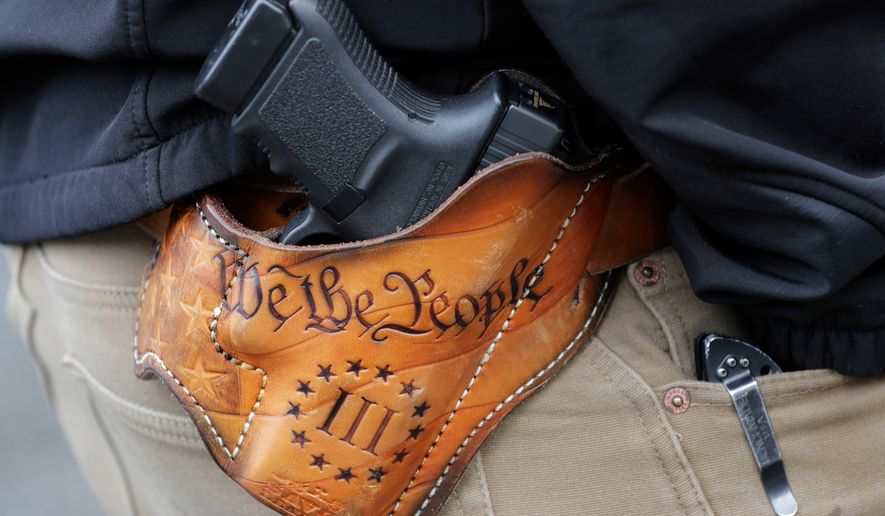Scores of federally funded gun violence studies have been launched since Congress opened the spigot for taxpayer dollars for the research, which was closed for more than two decades over conservatives’ fears that it would advance the cause of gun control advocates.
Marking a significant defeat for the gun lobby, lawmakers in Washington have set aside roughly $75 million since 2019 for the National Institutes of Health and the Centers for Disease Control and Prevention to research gun violence.
The studies are examining the effectiveness of various programs, including an online youth educational website, a project to turn empty street corners into gardens and a close look at K-12 firearm prevention tactics.
NIH and CDC dole out the taxpayer dollars to universities to do the research. Funding includes:
• $2.25 million to the University of Michigan at Ann Arbor to determine whether turning vacant lots into green spaces, such as community gardens, pocket parks or green infrastructure, will reduce firearm violence in Detroit.
• $2.1 million to Virginia Commonwealth University to study one of its programs that gives gun violence victims counseling and several months of case management services. The goal is to stop victims from retaliating against those who injured them.
SEE ALSO: Democrats hammer Hulu for censorship after it restricts political ads on guns, abortion
• $1.96 million to Columbia University Health Sciences to examine the effectiveness of firearm prevention tactics by K-12 schools, such as metal detectors, armed resource officers and shooting drills. Researchers worry that such measures could have “unintended consequences, and may exacerbate disparities related to school demographics and student discipline.”
Sen. Christopher Murphy, Connecticut Democrat and a leading gun control advocate, has called the research spending “small steps forward on gun safety.”
Most Republicans disagree.
Sen. John Cornyn, Texas Republican, said plenty of privately funded studies are available without the $25 million that Congress contributes to gun violence research each year.
“I don’t think the federal government using tax dollars to do additional research is necessary or justified,” he told The Washington Times. “The problem is not the lack of knowledge or study. It’s just the challenges of dealing with human behavior. Democrats want to make the inanimate object the enemy, but it’s pretty clear to me that that’s part of an effort to ultimately deny law-abiding citizens access to their Second Amendment rights.”
Congress has split the $25 million gun research spending evenly between the NIH and the CDC each year since lawmakers reached an agreement in a December 2019 budget bill.
SEE ALSO: Biden to pitch $37 billion anti-crime plan in Pennsylvania amid surging gun violence
For about 23 years before that, pressure from the National Rifle Association and conservative lawmakers cut off funding for NIH and CDC research on gun violence.
Other federally funded research includes:
• $1.95 million to the University of Alabama at Birmingham to evaluate the effectiveness of ShootSafe, a website designed to teach children about firearms safety.
• $1.87 million for the University of Chicago to examine the Rapid Employment and Development Initiative, a local job and therapy program. Researchers are studying the effectiveness of the cognitive behavior social service and whether it helps those at high risk for gun violence.
• $1.24 million to the University of Colorado Denver to determine whether reducing access to firearms during times of suicide risk can save lives. Specifically, they want to see whether temporary and voluntary firearms storage outside the home prevents suicides. A website run by the Colorado Firearm Safety Coalition details where residents can take their guns to firearms retailers, ranges or law enforcement agencies for safekeeping.
• $1.21 million to the University of Michigan at Ann Arbor to examine whether storing firearms locked and unloaded will curb youth suicides in Alaska Native communities.
• $650,000 to the University of Colorado to study whether Gun Shop Projects, which are partnerships between the firearms community and the local public or community health agencies, will reduce suicides. The intent is to reduce firearm owners’ access to their guns “during times of crisis.”
• $125,000 to the University of Connecticut in Storrs to research how youth violence could be curbed through technology and what role online threats play in real-world violence.
Democrats and gun control advocates insist it is money well spent and will shed new light on ways to prevent gun violence.
• Ramsey Touchberry can be reached at rtouchberry@washingtontimes.com.




Please read our comment policy before commenting.